Makita BTS130 Manual
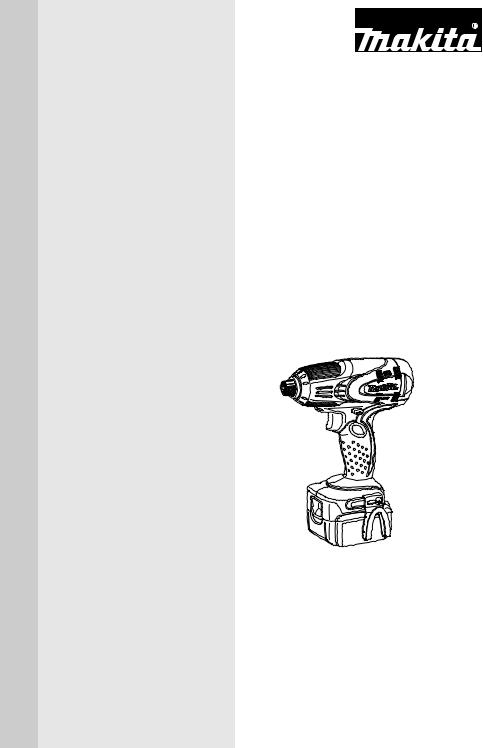
I N S T R U C T I O N M A N U A L
M A N U E L D ' I N S T R U C T I O N
M A N U A L D E I N S T R U C C I O N E S
Cordless Oil-impulse Driver
Visseuse oléopneumatique à impulsions sans fil
Atornillador de impacto hidraulico (aceite) a batería
BTS130
006795
 WARNING:
WARNING:
For your personal safety, READ and UNDERSTAND before using. SAVE THESE INSTRUCTIONS FOR FUTURE REFERENCE.
 AVERTISSEMENT:
AVERTISSEMENT:
Pour votre propre sécurité, prière de lire attentivement avant l’utilisation. GARDER CES INSTRUCTIONS POUR RÉFÉRENCE ULTÉRIEURE.
 ADVERTENCIA:
ADVERTENCIA:
Para su seguridad personal, LEA DETENIDAMENTE este manual antes de usar la herramienta. GUARDE ESTAS INSTRUCCIONES PARA FUTURA REFERENCIA.

ENGLISH
SPECIFICATIONS
|
Model |
BTS130 |
|
|
|
|
|
|
|
Machine screw |
M4 - M8 (5/32” - 5/16”) |
|
|
|
|
Capacities |
|
Standard bolt |
M6 - M10 (1/4” - 3/8”) |
|
|
|
|
|
|
High tensile bolt |
M6 - M8 (1/4” - 5/16”) |
|
|
|
|
|
No load speed (RPM) |
0 - 2,400/min. |
|
|
|
|
|
|
Impacts per minute |
0 - 1,600 |
|
|
|
|
|
|
Overall length |
183 mm (7-1/4”) |
|
|
|
|
|
|
Net weight |
1.7 kg (3.8 lbs) |
|
|
|
|
|
|
Rated voltage |
D.C.14.4 V |
|
|
|
||
Standard battery cartridges |
BL1430 |
||
|
|
|
|
•Due to our continuing programme of research and development, the specifications herein are subject to change without notice.
•Note: Specifications may differ from country to country.
GENERAL SAFETY RULES
GEA002-3
WARNING:
Read all instructions. Failure to follow all instructions listed below may result in electric shock, fire and/or serious injury. The term “power tool” in all of the warnings listed below refers to your mains-operated (corded) power tool or battery-operated (cordless) power tool.
SAVE THESE INSTRUCTIONS
Work area safety
1.Keep work area clean and well lit. Cluttered and dark areas invite accidents.
2.Do not operate power tools in explosive atmospheres, such as in the presence of flammable liquids, gases or dust. Power tools create sparks which may ignite the dust or fumes.
3.Keep children and bystanders away while operating a power tool. Distractions can cause you to lose control.
Electrical safety
4.Power tool plugs must match the outlet. Never modify the plug in any way. Do not use any adapter plugs with earthed (grounded) power tools. Unmodified plugs and matching outlets will reduce risk of electric shock.
5.Avoid body contact with earthed or grounded surfaces such as pipes, radiators, ranges and refrigerators. There is an increased risk of electric shock if your body is earthed or grounded.
6.Do not expose power tools to rain or wet conditions. Water entering a power tool will increase the risk of electric shock.
7.Do not abuse the cord. Never use the cord for carrying, pulling or unplugging the power tool. Keep cord away from heat, oil, sharp edges or moving parts. Damaged or entangled cords increase the risk of electric shock.
8.When operating a power tool outdoors, use an extension cord suitable for outdoor use. Use of a cord suitable for outdoor use reduces the risk of electric shock.
Personal safety
9.Stay alert, watch what you are doing and use common sense when operating a power tool. Do not use a power tool while you are tired or under the influence of drugs, alcohol or medication. A moment of inattention while operating power tools may result in serious personal injury.
10.Use safety equipment. Always wear eye protection. Safety equipment such as dust mask, non-skid safety shoes, hard hat, or hearing protection used for appropriate conditions will reduce personal injuries.
11.Avoid accidental starting. Ensure the switch is in the off-position before plugging in. Carrying power tools with your finger on the switch or plugging in power tools that have the switch on invites accidents.
2

12.Remove any adjusting key or wrench before turning the power tool on. A wrench or a key left attached to a rotating part of the power tool may result in personal injury.
13.Do not overreach. Keep proper footing and balance at all times. This enables better control of the power tool in unexpected situations.
14.Dress properly. Do not wear loose clothing or jewellery. Keep your hair, clothing, and gloves away from moving parts. Loose clothes, jewellery or long hair can be caught in moving parts.
15.If devices are provided for the connection of dust extraction and collection facilities, ensure these are connected and properly used. Use of these devices can reduce dust-related hazards.
Power tool use and care
16.Do not force the power tool. Use the correct power tool for your application. The correct power tool will do the job better and safer at the rate for which it was designed.
17.Do not use the power tool if the switch does not turn it on and off. Any power tool that cannot be controlled with the switch is dangerous and must be repaired.
18.Disconnect the plug from the power source and/ or the battery pack from the power tool before making any adjustments, changing accessories, or storing power tools. Such preventive safety measures reduce the risk of starting the power tool accidentally.
19.Store idle power tools out of the reach of children and do not allow persons unfamiliar with the power tool or these instructions to operate the power tool. Power tools are dangerous in the hands of untrained users.
20.Maintain power tools. Check for misalignment or binding of moving parts, breakage of parts and any other condition that may affect the power tools operation. If damaged, have the power tool repaired before use. Many accidents are caused by poorly maintained power tools.
21.Keep cutting tools sharp and clean. Properly maintained cutting tools with sharp cutting edges are less likely to bind and are easier to control.
22.Use the power tool, accessories and tool bits etc. in accordance with these instructions and in the manner intended for the particular type of power tool, taking into account the working conditions and the work to be performed. Use of the power tool for operations different from those intended could result in a hazardous situation.
Battery tool use and care
23.Ensure the switch is in the off position before inserting battery pack. Inserting the battery pack into power tools that have the switch on invites accidents.
24.Recharge only with the charger specified by the manufacturer. A charger that is suitable for one type of battery pack may create a risk of fire when used with another battery pack.
25.Use power tools only with specifically designated battery packs. Use of any other battery packs may create a risk of injury and fire.
26.When battery pack is not in use, keep it away from other metal objects like paper clips, coins, keys, nails, screws, or other small metal objects that can make a connection from one terminal to another. Shorting the battery terminals together may cause burns or a fire.
27.Under abusive conditions, liquid may be ejected from the battery, avoid contact. If contact accidentally occurs, flush with water. If liquid contacts eyes, additionally seek medical help. Liquid ejected from the battery may cause irritation or burns.
Service
28.Have your power tool serviced by a qualified repair person using only identical replacement parts. This will ensure that the safety of the power tool is maintained.
29.Follow instruction for lubricating and changing accessories.
30.Keep handles dry, clean and free from oil and grease.
SPECIFIC SAFETY RULES
GEB012-1
DO NOT let comfort or familiarity with product (gained from repeated use) replace strict adherence to impact driver safety rules. If you use this tool unsafely or incorrectly, you can suffer serious personal injury.
1.Wear ear protectors with impact drills. Exposure to noise can cause hearing loss.
2.Hold power tools by insulated gripping surfaces when performing an operation where the cutting tool may contact hidden wiring or its own cord.
Contact with a “live” wire will make exposed metal parts of the tool “live” and shock the operator.
3.Always be sure you have a firm footing.
Be sure no one is below when using the tool in high locations.
4.Hold the tool firmly.
SAVE THESE INSTRUCTIONS
3
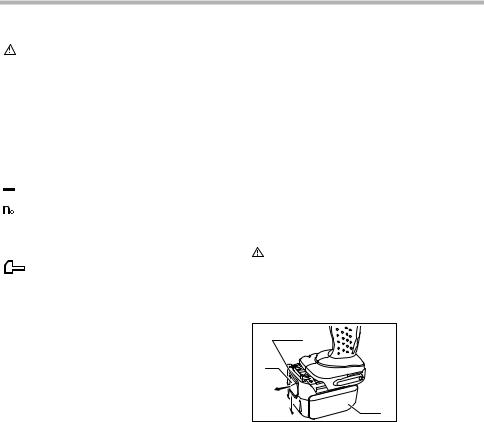
WARNING:
MISUSE or failure to follow the safety rules stated in this instruction manual may cause serious personal injury.
SYMBOLS
USD302-1
The followings show the symbols used for tool.
V............................ |
volts |
||
|
|
|
direct current |
|
|
....................... |
|
|
|
....................... |
no load speed |
.../min.................... |
revolutions or reciprocation per |
||
|
|
|
minute |
|
|
.................. |
number of blow |
|
|
|
ENC007-2 |
IMPORTANT SAFETY INSTRUCTIONS
FOR BATTERY CARTRIDGE
1.Before using battery cartridge, read all instructions and cautionary markings on (1) battery charger, (2) battery, and (3) product using battery.
2.Do not disassemble battery cartridge.
3.If operating time has become excessively shorter, stop operating immediately. It may result in a risk of overheating, possible burns and even an explosion.
4.If electrolyte gets into your eyes, rinse them out with clear water and seek medical attention right away. It may result in loss of your eyesight.
5.Do not short the battery cartridge:
(1)Do not touch the terminals with any conductive material.
(2)Avoid storing battery cartridge in a container with other metal objects such as nails, coins, etc.
(3)Do not expose battery cartridge to water or rain.
A battery short can cause a large current flow, overheating, possible burns and even a breakdown.
6.Do not store the tool and battery cartridge in locations where the temperature may reach or exceed 50°C (122°F).
7.Do not incinerate the battery cartridge even if it is severely damaged or is completely worn out. The battery cartridge can explode in a fire.
8.Be careful not to drop or strike battery.
SAVE THESE INSTRUCTIONS.
Tips for maintaining maximum battery life
1.Charge the battery cartridge before completely discharged.
Always stop tool operation and charge the battery cartridge when you notice less tool power.
2.Never recharge a fully charged battery cartridge.
Overcharging shortens the battery service life.
3.Charge the battery cartridge with room temperature at 10°C - 40°C (50°F - 104°F). Let a hot battery cartridge cool down before charging it.
FUNCTIONAL DESCRIPTION
CAUTION:
•Always be sure that the tool is switched off and the battery cartridge is removed before adjusting or checking function on the tool.
Installing or removing battery cartridge
006590 |
3 |
2 |
1 |
1.Battery cartridge
2.Button
3.Red part
•Always switch off the tool before insertion or removal of the battery cartridge.
•To remove the battery cartridge, withdraw it from the tool while sliding the button on the front of the cartridge.
•To insert the battery cartridge, align the tongue on the battery cartridge with the groove in the housing and slip it into place. Always insert it all the way until it locks in place with a little click. If you can see the red part on the upper side of the button, it is not locked completely. Insert it fully until the red part cannot be seen. If not, it may accidentally fall out of the tool, causing injury to you or someone around you.
•Do not use force when inserting the battery cartridge. If the cartridge does not slide in easily, it is not being inserted correctly.
4

Switch action |
Reversing switch action |
006796 |
006798 |
1. Switch trigger |
|
A |
B |
|
1 |
1 |
|
1.Reversing switch lever
CAUTION:
•Before inserting the battery cartridge into the tool, always check to see that the switch trigger actuates properly and returns to the “OFF” position when released.
To start the tool, simply pull the switch trigger. Tool speed is increased by increasing pressure on the switch trigger. Release the switch trigger to stop.
Electric brake
This tool is equipped with an electric brake. If the tool consistently fails to quickly stop after switch trigger release, have tool serviced at a Makita service center.
Lighting up the front lamp
006797
1. Lamp
1
CAUTION:
•Do not look in the light or see the source of light directly.
Pull the switch trigger to light up the lamp. The lamp keeps on lighting while the switch trigger is being pulled. The light automatically goes out 10 - 15 seconds after the switch trigger is released.
NOTE:
•Use a dry cloth to wipe the dirt off the lens of lamp. Be careful not to scratch the lens of lamp, or it may lower the illumination.
This tool has a reversing switch to change the direction of rotation. Depress the reversing switch lever from the A side for clockwise rotation or from the B side for counterclockwise rotation.
When the reversing switch lever is in the neutral position, the switch trigger cannot be pulled.
CAUTION:
•Always check the direction of rotation before operation.
•Use the reversing switch only after the tool comes to a complete stop. Changing the direction of rotation before the tool stops may damage the tool.
•When not operating the tool, always set the reversing switch lever to the neutral position.
Characteristics of Cordless Oil-impulse Driver
The Makita Cordless Oil-impulse Driver is a hydraulically operated impact tool using oil viscosity to produce impacts. Since oil viscosity changes with the temperature, be aware of the following two points when operating the tool.
1.Avoid using the tool below -5 degrees of temperature. When the tool temperature goes down below the degrees, this may cause damage to the motor of tool due to poor impulse.
2.When the tool becomes too hot, it may take longer to set screws
3.The tool can overheat, causing a failure or hand burn if you operate it continuously for long hours. Let the tool cool off for more than 30 minutes before changing batteries during a long, continuous job.
ASSEMBLY
CAUTION:
•Always be sure that the tool is switched off and the battery cartridge is removed before carrying out any work on the tool.
5
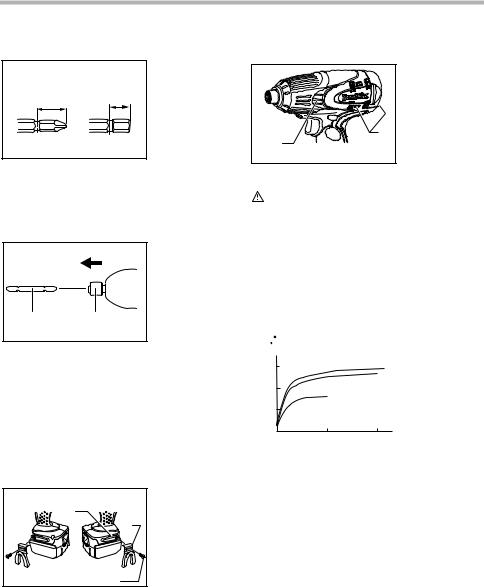
Installing or removing driver bit or socket bit |
OPERATION |
||
|
001266 |
006843 |
|
|
|
||
|
|
1. Air vents |
|
12 mm |
9 mm |
2. Cooling down oil |
|
unit |
|||
(15/32”) |
(3/8”) |
||
|
|||
|
|
2 |
|
|
|
1 |
|
Use only the driver bit or socket bit shown in the figure. Do not use any other driver bit or socket bit.
To install the bit, pull the sleeve in the direction of the arrow and insert the bit into the sleeve as far as it will go. Then release the sleeve to secure the bit.
001267
1. Bit
2. Sleeve
1 |
2 |
To remove the bit, pull the sleeve in the direction of the arrow and pull the bit out firmly.
NOTE:
• If the bit is not inserted deep enough into the sleeve, the sleeve will not return to its original position and the bit will not be secured. In this case, try re-inserting the bit according to the instructions above.
Hook
006592
1. Screw
2. Hook
3
3. Groove
2
1
The hook is convenient for temporarily hanging the tool. This can be installed on either side of the tool.
To install the hook, insert it into a groove in the tool housing on either side and then secure it with a screw. To remove, loosen the screw and then take it out.
CAUTION:
•Never obstruct the air vents on the side of the tool for cooling down oil unit and motor during operation. Failure to do so may cause the tool excessive hotness and damage.
The proper fastening torque may differ depending upon the kind or size of the screw/bolt, the material of the workpiece to be fastened, etc. The relation between fastening torque and fastening time is shown in the figures.
|
|
|
006841 |
|
Standard bolt |
|
|
|
N m |
|
|
torqueFastening |
(ft lbs) |
|
torquefasteningProper |
|
|
||
|
30 |
|
M10 |
|
(306) |
|
|
|
20 |
|
M8 |
|
|
|
|
|
(204) |
|
|
|
10 |
M6 |
|
|
|
|
|
|
(102) |
|
|
|
0 |
0.5 |
1.0 |
|
|
Fastening time |
(S) |
|
|
|
|
6
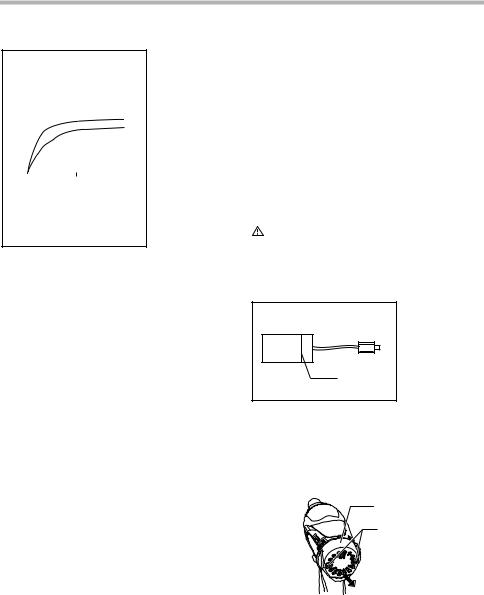
006842
High tensile bolt
N m (ft
m (ft lbs)
lbs)
|
30 |
|
|
M8 |
torquefasteningProper |
|||
torqueFastening |
(306) |
|
|
|||||
|
|
|
|
|
|
|||
|
|
|
|
|
|
|
|
|
|
20 |
|
|
M6 |
|
|||
|
(204) |
|
|
|
||||
|
|
|
|
|||||
|
10 |
|
|
|
|
|
|
|
|
(102) |
|
|
|
|
|
|
|
|
|
|
|
|
|
|
|
|
|
0 |
0.5 |
1.0 |
|
||||
|
|
|
Fastening time |
(S) |
|
|||
Hold the tool firmly and place the point of the driver bit in the screw head. Apply forward pressure to the tool to the extent that the bit will not slip off the screw and turn the tool on to start operation.
NOTE:
•Use the proper bit for the head of the screw/bolt that you wish to use.
•When fastening screw M8 or smaller, carefully adjust pressure on the switch trigger so that the screw is not damaged.
•Hold the tool pointed straight at the screw.
•If you tighten the screw for a time longer than shown in the figures, the screw or the point of the driver bit may be overstressed, stripped, damaged, etc. Before starting your job, always perform a test operation to determine the proper fastening time for your screw.
•The fastening torque differs according to the increase in the tool hotness.
•When driving wood screws, predrill pilot holes with diameter smaller than the wood screws to make driving easier and to prevent splitting of the workpiece.
•The diameter of wood screws that are within the tool capacity is not always the same and depends on the kind of material to be driven on. Make trial driving with several screws before actual operation.
The fastening torque is affected by a wide variety of factors including the following. After fastening, always check the torque with a torque wrench.
1.When the battery cartridge is discharged almost completely, voltage will drop and the fastening torque will be reduced.
2.Driver bit or socket bit
Failure to use the correct size driver bit or socket bit will cause a reduction in the fastening torque.
3.Bolt
•Even though the torque coefficient and the class of bolt are the same, the proper fastening torque will differ according to the diameter of bolt.
•Even though the diameters of bolts are the same, the proper fastening torque will differ according to the torque coefficient, the class of bolt and the bolt length.
4.The manner of holding the tool or the material of driving position to be fastened will affect the torque.
5.Operating the tool at low speed will cause a reduction in the fastening torque.
MAINTENANCE
CAUTION:
•Always be sure that the tool is switched off and the battery cartridge is removed before attempting to perform inspection or maintenance.
Replacing carbon brushes
006258
1. Limit mark
 1
1
Replace when they wear down to the limit mark. Keep the carbon brushes clean and free to slip in the holders. Both carbon brushes should be replaced at the same time. Use only identical carbon brushes.
Use a screwdriver to remove two screws then remove the rear cover.
006799
1 |
1. |
Rear cover |
|
2. |
Screws |
||
|
|||
2 |
|
|
|
|
|
|
7
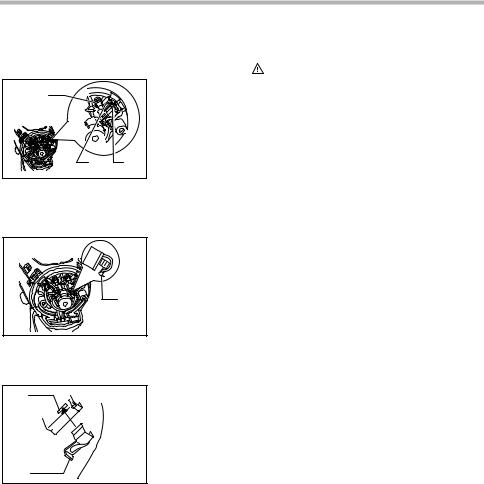
Raise the arm part of the spring and then place it in the recessed part of the housing with a slotted bit screwdriver of slender shaft or the like.
006260
1. Spring
1 |
2. Arm |
|
3. Recessed part
2 3
Use pliers to remove the carbon brush cap of the carbon brushes. Take out the worn carbon brushes, insert the new ones and replace the carbon brush cap in reverse.
006261
1. Carbon brush cap
1
Make sure that the carbon brush cap have fit into the holes in brush holders securely.
|
006304 |
1 |
1. Hole |
|
2. Carbon brush cap
2
Reinstall the rear cover and tighten two screws securely.
After replacing brushes, insert the battery cartridge into the tool and break in brushes by running tool with no load for about 1 minute. Then check the tool while running and electric brake operation when releasing the switch trigger. If electric brake is not working well, ask your local Makita service center for repair.
To maintain product SAFETY and RELIABILITY, repairs, any other maintenance or adjustment should be performed by Makita Authorized or Factory Service Centers, always using Makita replacement parts.
ACCESSORIES
CAUTION:
•These accessories or attachments are recommended for use with your Makita tool specified in this manual. The use of any other accessories or attachments might present a risk of injury to persons. Only use accessory or attachment for its stated purpose.
If you need any assistance for more details regarding these accessories, ask your local Makita Service Center.
•Screw bits
•Hook
•Plastic carrying case
•Various type of Makita genuine batteries and chargers
EN0006-1
MAKITA LIMITED ONE YEAR WARRANTY
Warranty Policy
Every Makita tool is thoroughly inspected and tested before leaving the factory. It is warranted to be free of defects from workmanship and materials for the period of ONE YEAR from the date of original purchase. Should any trouble develop during this one year period, return the COMPLETE tool, freight prepaid, to one of Makita’s Factory or Authorized Service Centers. If inspection shows the trouble is caused by defective workmanship or material, Makita will repair (or at our option, replace) without charge.
This Warranty does not apply where:
•repairs have been made or attempted by others:
•repairs are required because of normal wear and tear:
•the tool has been abused, misused or improperly maintained:
•alterations have been made to the tool.
IN NO EVENT SHALL MAKITA BE LIABLE FOR ANY INDIRECT, INCIDENTAL OR CONSEQUENTIAL DAMAGES FROM THE SALE OR USE OF THE PRODUCT. THIS DISCLAIMER APPLIES BOTH DURING AND AFTER THE TERM OF THIS WARRANTY.
MAKITA DISCLAIMS LIABILITY FOR ANY IMPLIED WARRANTIES, INCLUDING IMPLIED WARRANTIES OF “MERCHANTABILITY” AND “FITNESS FOR A SPECIFIC PURPOSE,” AFTER THE ONE YEAR TERM OF THIS WARRANTY.
This Warranty gives you specific legal rights, and you may also have other rights which vary from state to state. Some states do not allow the exclusion or limitation of incidental or consequential damages, so the above limitation or exclusion may not apply to you. Some states do not allow limitation on how long an implied warranty lasts, so the above limitation may not apply to you.
8

FRANÇAIS
SPÉCIFICATIONS
|
Modèle |
BTS130 |
|
|
|
|
|
|
|
Vis de mécanique |
M4 - M8 (5/32” - 5/16”) |
|
|
|
|
Capacités |
|
Boulon standard |
M6 - M10 (1/4” - 3/8”) |
|
|
|
|
|
|
Boulon à haute résistance |
M6 - M8 (1/4” - 5/16”) |
|
|
|
|
|
Vitesse à vide (T/MIN) |
0 - 2,400/min. |
|
|
|
|
|
|
Percussions par minute |
0 - 1,600 |
|
|
|
|
|
|
Longueur totale |
183 mm (7-1/4”) |
|
|
|
|
|
|
Poids net |
1.7 kg (3.8 lbs) |
|
|
|
|
|
|
Tension nominale |
C.C. 14.4 V |
|
|
|
|
|
|
Batteries standard |
BL1430 |
|
|
|
|
|
•Le fabricant se réserve le droit de modifier sans avertissement les spécifications.
•Note: Les spécifications peuvent varier selon les pays.
CONSIGNES DE SÉCURITÉ GÉNÉRALES
GEA002-3
AVERTISSEMENT:
Lisez toutes les instructions. Il y a risque de choc électrique, d’incendie et/ou de blessure grave si les instructions énumérées ci-dessous ne sont pas toutes respectées. Le terme “outil électrique” qui figure sur tous les avertissements énumérés ci-dessous fait référence à un outil électrique alimenté par une prise de courant ou par une batterie.
CONSERVEZ CES
INSTRUCTIONS
Sécurité de la zone de travail
1.Maintenez la zone de travail propre et bien éclairée. Les zones de travail encombrées et sombres ouvrent grande la porte aux accidents.
2.N’utilisez pas les outils électriques dans des atmosphères explosives, telles qu’en présence de liquides, de gaz ou de poussières inflammables. Les outils électriques produisent des étincelles au contact desquelles la poussière ou les vapeurs risqueraient de s’enflammer.
3.Assurez-vous qu’aucun enfant ou passant ne s’approche pendant que vous utilisez un outil électrique. Vous risquez de perdre la maîtrise de l’outil si votre attention est détournée.
Sécurité en matière d’électricité
4.La fiche des outils électriques est conçue pour s’adapter parfaitement à la prise de courant. Ne modifiez jamais la fiche de quelque façon que ce soit. N’utilisez aucun adaptateur de fiche sur les outils électriques avec mise à la terre. En ne modifiant pas les fiches et en les insérant dans des prises de courant pour lesquelles elles ont été conçues vous réduirez les risques de choc électrique.
5.Évitez tout contact corporel avec les surfaces mises à la terre, telles que les tuyaux, radiateurs, cuisinières et réfrigérateurs. Le risque de choc
électrique est plus élevé si votre corps se trouve mis
àla terre.
6.N’exposez pas les outils électriques à la pluie et évitez qu’ils ne soient mouillés. Les risques de choc électrique sont plus élevés lorsque de l’eau pénètre dans un outil électrique.
7.Ne maltraitez pas le cordon. N’utilisez jamais le cordon pour transporter, tirer ou débrancher l’outil électrique. Maintenez le cordon à l’écart des sources de chaleur, de l’huile, des objets à bords tranchants et des pièces en mouvement.
Le risque de choc électrique est plus élevé lorsque les cordons sont endommagés ou enchevêtrés.
8.Lorsque vous utilisez un outil électrique à l’extérieur, utilisez un cordon prolongateur prévu
àcette fin. Les risques de choc électrique sont moindres lorsqu’un cordon conçu pour l’extérieur est utilisé.
Sécurité personnelle
9.Restez alerte, attentif à vos mouvements et faites preuve de bon sens lorsque vous utilisez un outil électrique. Évitez d’utiliser un outil
9
